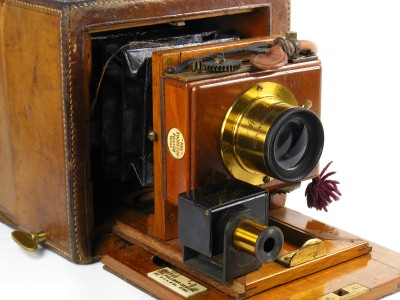The Pullman Detective Camera
S. J. Levi & Company
| Name: | The Pullman Detective Camera |
| Manufacturer: | S. J. Levi & Co, London |
| Country of Origin: | United Kingdom |
| Production Period: | Not known |
| Plate / Film Size: | ¼ plate |
| Lens: | Wray London 7" Platystigmat f7.3 (Serial 13123) |
| Shutter: | Thornton Pickard "Time" roller blind shutter with original air bulb |
| Movements: | Rising front on lens standard; tilt on back |
| Dimensions (h x l x w): | |
| Date of this Example: | c1896 |
| Serial Number: | No obvious markings apart from serial on the lens (13123) |
| Availability: |
|
| Inventory Number: | 472 |
Description
Very attractive and well built hide satchel style detective camera in ¼ plate size, with square section bellows. The Wray lens seems to be contemporary, supported by the Lens Vade Mecum [10], but this does not help date it any more closely.
When closed the camera resembles a leather case. The top of the bag (fitted with a lock) opens to reveal the focusing screen while the bottom of the bag is released by a button built into the case and hinges down allowing the bellows to be drawn out.
The camera is named as "The Pullman Camera" on the label on the baseboard and also under the satchel lid, embossed into the hide case. The ivory label carries the makers name as "S. J. L. & Co" and is also marked "Rd" in one corner and "211201" in the opposite corner - is this the patent number perhaps? Curiously, it looks as if the nameplate may have been added as an after thought as a recess has had to be cut into the mahogany frame of the camera body to allow the front to close.
There is a small brass "key" stored inside the camera, which has a square inner section. This slots into a small keyway on the lower edge (same side as viewfinder), and then operates the gear which winds the camera out and back very smoothly. It also has an original brass tripod mounting screw.
The hide case is in good condition generally, with some surface marking, but sound. However, the satchel lid hinge has failed, leaving the lid section cleanly broken away from the remainder of the casing. The hinges on the side panels are showing wear, but remain intact. Failure of hinges formed in the leather is not unusual.
The lid has elastic built in (also seen in photos of another example), which presumably was intended to hold the DDS. None are with the camera. However it does have its viewing screen holder, albeit that the glass has long since disappeared. It has a tilting back and rising front.
The shutter still has its pull string and toggle attached and it also has its bulb still attached, although this has dried out and split. The bellows are in very good order. The camera is equipped with a viewfinder and must be original to the camera as the drop down section door has a recess for the end of the finder lens.
The camera is different in design in small details to the version in Channing & Dunn [2, p73] British Camera Makers, which has brass side rails for the lens standard and a narrower pull out section.
|
Photos copyright © 2009 David Purcell. Do not use without permission. |
Notes
These cameras are scarce and research on the internet does not turn up many examples. The example at the National Media Museum (Bradford) is very similar in form except that the case is in black hide rather than tan and the camera has been fitted with a Pullman plate changer that curiously doesn't seem to fit properly.
How many excuses can you come up with to justify buying an expensive camera? This one was my 50th birthday present to myself!
![[ ]](../../images/unchecked.png)
![[x]](../../images/checked.png)












